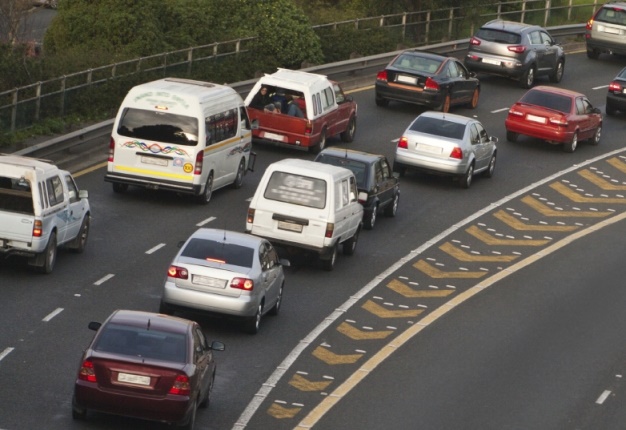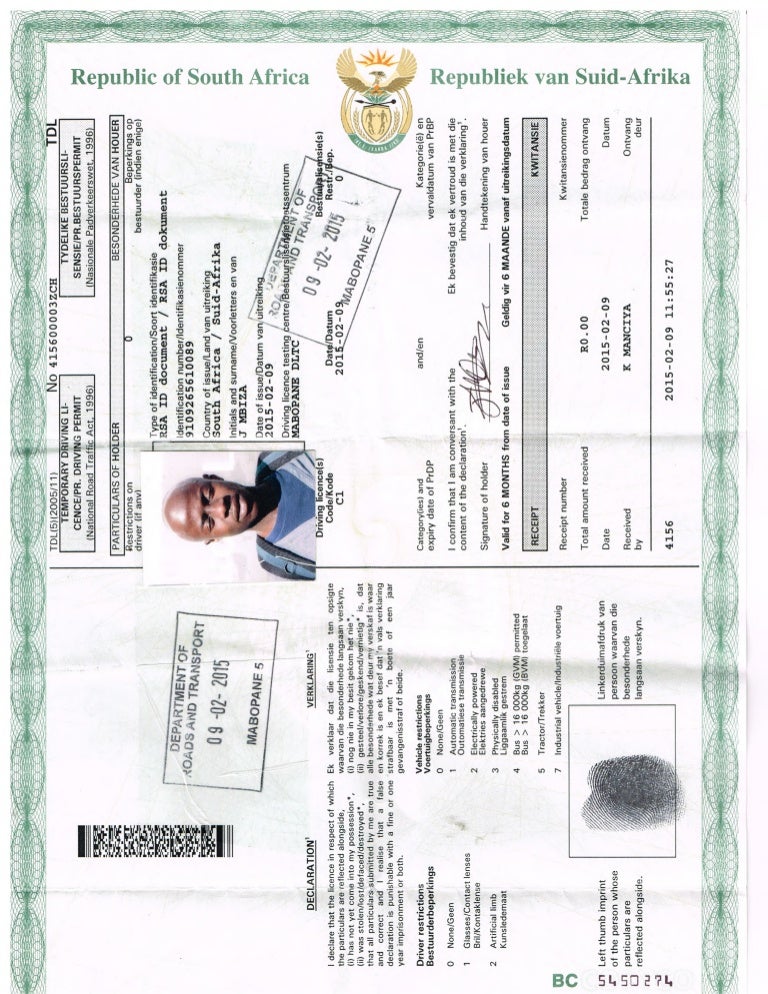Drivers Licence Department South Africa


In, the driving licence is the official document which authorises the holder to drive a on a. Driving licences are issued by authorised driving licence testing centres, which are run by the under the supervision of the provincial and national Departments of Transport.
Since 1998, the driving licence has been issued in a '; before then it was included in the holder's national. The minimum age to hold a licence is 18.Apply for a driving licence South African with the exception of Code A1 for which the minimum age is 16. Licence codes [ ] Driving licences are issued with various codes that indicate the types of vehicle that may be driven with that licence; the codes are shown in the following table.
Code Vehicle classes Includes A1 with an of 125 cubic centimetres or less A Motorcycles with an engine capacity greater than 125 cc Code A1 Light motor vehicles B Vehicles (except motorcycles) with of 3 500 kilograms or less; and, and goods vehicles with (GVM) of 3 500 kg or less. A with GVM of 750 kg or less may be attached. Ground Services X Keygen. EB with (GCM) of 3 500 kg or less; and vehicles allowed by Code B but with a trailer with GVM greater than 750 kg. Code B Heavy motor vehicles C1 Vehicles with tare weight between 3 500 kg and 16 000 kg;, and goods vehicles with GVM between 3 500 kg and 16 000 kg. A trailer with GVM of 750 kg or less may be attached. Code B C Buses and goods vehicles with GVM greater than 16 000 kg. A trailer with GVM of 750 kg or less may be attached.
Gallows Hill (Cape Town) Traffic Department - Green Point / Gallows Hill, Cape Town, Western Cape, South Africa. Aug 18, 2017. All South African drivers are required to have a credit card format driving licence. Bring your ID,; four photographs and valid learner's licence to make your appointment,; complete the green colour-coded form, DL1 provided by the traffic department,; bring a pen to complete your forms, and; a proof of.
Codes B and C1 EC1 Articulated vehicles with GCM between 3 500 kg and 16 000 kg; and vehicles allowed by Code C1 but with a trailer with GVM greater than 750 kg. Codes B, EB and C1 EC Articulated vehicles with GCM greater than 18 000 kg; and vehicles allowed by Code C but with a trailer with GVM greater than 750 kg. Codes B, EB, C1, C and EC1 code c1/a Obtaining a licence [ ] Before applying for a driving licence, a prospective driver must first obtain a learner's licence. The learner's test is a multiple-choice test that examines knowledge of vehicle controls,, and.
The following criteria required: [ ] • Rules of the road - There are 30 questions in this category with 22 being the pass mark • Vehicle controls - There are 8 questions in this section, the required pass mark is 6 • Road signs, road markings and traffic signals - There are 30 questions in this category with a pass mark of 23 Three types of learner's licence are issued: • Code 1: motorcycles. • Code 2: vehicles (except motorcycles) with tare weight of 3 500 kilograms or less; minibuses, buses and goods vehicles with GVM of 3 500 kg or less; and articulated vehicles with GCM of 3 500 kg or less.
• Code 3: all vehicles (except motorcycles). The minimum age for a Code 1 or 2 licence is 17, and for a Code 3 licence it is 18. At the age of 16 a Code 1 licence limited to motorcycles with engine capacity under 125 cc may be obtained. Learner's licences are valid for 24 months, and, except for Code 1 licences, require that the learner be accompanied by a fully licensed driver.
It is not compulsory for a learner driver to have a big red 'L' on the rear window, but it is recommended so that other drivers can have patience with the driver. With the learner's licence, the prospective driver can take a driving test to obtain their driving licence.
The driving test has two components: the first is the yard test, in which the applicant demonstrates various parking and turning manoeuvres in a specially constructed parking lot. If the yard test is successful, it is followed by the road test, in which the applicant demonstrates their driving ability on the public roads, following the instructions of the examiner. Some errors on the test, such as a collision, speeding, or rolling backwards when moving off, will cause an instant failure of the test. Other errors cause the driver to lose points; if too many points are lost, this will also cause failure. If the applicant is successful, they will be issued with a paper Temporary Driving Licence, which is valid for 6 months from the date of issue.